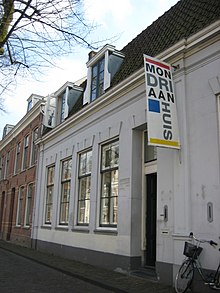
Utrecht, officially the Province of Utrecht, is a province of the Netherlands. It is located in the centre of the country, bordering the Eemmeer in the north-east, the province of Gelderland in the east and south-east, the province of South Holland in the west and south-west and the province of North Holland in the north-west and north. The province of Utrecht has a population of 1,353,596 as of November 2019. With a land area of approximately 1,485 square kilometres (573 sq mi), it is the smallest province in the country. Apart from its eponymous capital, major cities and towns in the province are Amersfoort, Houten, IJsselstein, Nieuwegein, Veenendaal and Zeist. The busiest railway station in the Netherlands, Utrecht Centraal, is located in the province of Utrecht.

Amersfoort is a city and municipality in the province of Utrecht, Netherlands. As of 31 January 2023, the municipality had a population of 160,902, making it the second-largest of the province and fifteenth-largest of the country. Amersfoort is also one of the largest Dutch railway junctions with its three stations—Amersfoort Centraal, Schothorst and Vathorst—due to its location on two of the Netherlands' main east to west and north to south railway lines. The city was used during the 1928 Summer Olympics as a venue for the modern pentathlon events. Amersfoort marked its 750th anniversary as a city in 2009.

De Stijl, also known as Neoplasticism, was a Dutch art movement founded in 1917 in Leiden. De Stijl consisted of artists and architects. In a more narrow sense, the term De Stijl is used to refer to a body of work from 1917 to 1931 founded in the Netherlands. Proponents of De Stijl advocated pure abstraction and universality by a reduction to the essentials of form and colour. They simplified visual compositions to vertical and horizontal, using only black, white and primary colors.

The Hague School is a group of artists who lived and worked in The Hague between 1860 and 1890. Their work was heavily influenced by the realist painters of the French Barbizon school. The painters of the Hague school generally made use of relatively somber colors, which is why the Hague School is sometimes called the Gray School.

The Kunstmuseum Den Haag is an art museum in The Hague in the Netherlands, founded in 1866 as the Museum voor Moderne Kunst. Later, until 1998, it was known as Haags Gemeentemuseum, and until the end of September 2019 as Gemeentemuseum Den Haag. It has a collection of around 165,000 works, over many different forms of art. In particular, the Kunstmuseum is renowned for its large Mondrian collection, the largest in the world. Mondrian's last work, Victory Boogie-Woogie, is on display at the museum.

Victory Boogie Woogie is the last, unfinished work of the Dutch abstract painter Piet Mondrian, left incomplete when Mondrian died in New York in 1944. He was still working on it three days before dying. Since 1998 it has been in the collection of the Kunstmuseum, in The Hague. It has been said that "Mondrian's life and his affection for music are mirrored in the painting [and that it is] a testimony of the influence which New York had on Mondrian."
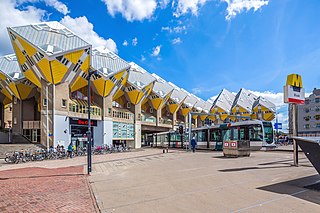
Cube houses are a set of innovative houses built in Helmond and Rotterdam in the Netherlands, designed by architect Piet Blom and based on the concept of "living as an urban roof": high density housing with sufficient space on the ground level, since its main purpose is to optimise the space inside. Blom tilted the cube of a conventional house corner upwards, and rested it upon a hexagon-shaped pylon. His design represents a village within a city, where each house represents a tree, and all the houses together, a forest. The central idea of the cube houses around the world is mainly optimizing the space, as a house, to a better distribution of the rooms inside.

Bart van der Leck was a Dutch painter, designer, and ceramicist. With Theo van Doesburg and Piet Mondrian he founded the De Stijl art movement.
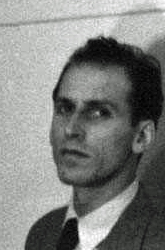
Harry Holtzman was an American artist and founding member of the American Abstract Artists group.
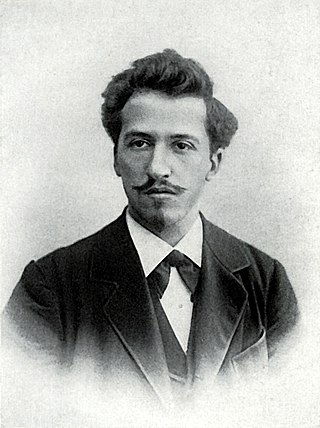
Pieter Cornelis Mondriaan, after 1906 known as Piet Mondrian, was a Dutch painter and art theoretician who is regarded as one of the greatest artists of the 20th century. He is known for being one of the pioneers of 20th-century abstract art, as he changed his artistic direction from figurative painting to an increasingly abstract style, until he reached a point where his artistic vocabulary was reduced to simple geometric elements.

Dutch art describes the history of visual arts in the Netherlands, after the United Provinces separated from Flanders. Earlier painting in the area is covered in Early Netherlandish painting and Dutch and Flemish Renaissance painting.
Neutelings Riedijk Architects is an architecture firm based in Rotterdam, the Netherlands, founded by Willem Jan Neutelings and Michiel Riedijk in 1987.

Simone Jeanet Kennedy-Doornbos is a Dutch politician of the Christian Union. Raised in a Reformed family in 't Harde, Kennedy studied medical biology at the University of Amsterdam. As a student, she ran for the municipal council of Amsterdam in 1991 as the lead candidate of the Reformed Political League (GPV) – a precursor of the Christian Union. She married historian James Kennedy in 1994, and the couple moved to Iowa that same year.
Marc Bijl is a Dutch artist who lives and works in Berlin. His works are based upon social issues and their use of symbols and rules. This can result in interventions in the public space, sculptures or installations that undermine or underline this perception of the world.

Joost Baljeu was a Dutch painter, sculptor and writer. He is known for his large outdoor painted steel structures.

Ewerdt Hilgemann is a German artist, currently living and working in the Netherlands.

Martine Theodora Bax is a Dutch-Canadian art historian and art critic in modern art. Her specializations are the work of Piet Mondrian and the relationship between art and Western Esotericism, especially Modern Theosophy and Anthroposophy.
Otto van Rees artist, Dutch citizen, born in Freiburg-im-Breisgau, Germany, died in Utrecht, Holland, mainly living in France and Switzerland during his career as an artist.
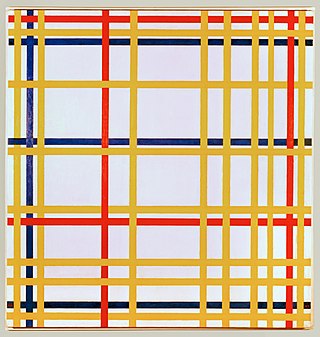
New York City is an 1942 oil-on-canvas painting by Piet Mondrian, completed in 1942. It is on display in the Musée National d'Art Moderne at the Centre Pompidou in Paris, France.

Composition with Yellow Lines is an 1933 abstract painting on canvas by Dutch artist Piet Mondrian. While following the grid like structures of his other abstract paintings, it is unusual in omitting the use of any black lines. Indeed, Mondrian's earlier writings on art had stated that any lines in his paintings had to be black; colour was reserved for the filled in rectangles. The painting is equally unusual in that none of the lines meet. He did not paint any further paintings with this design element until his move to New York in 1940.
